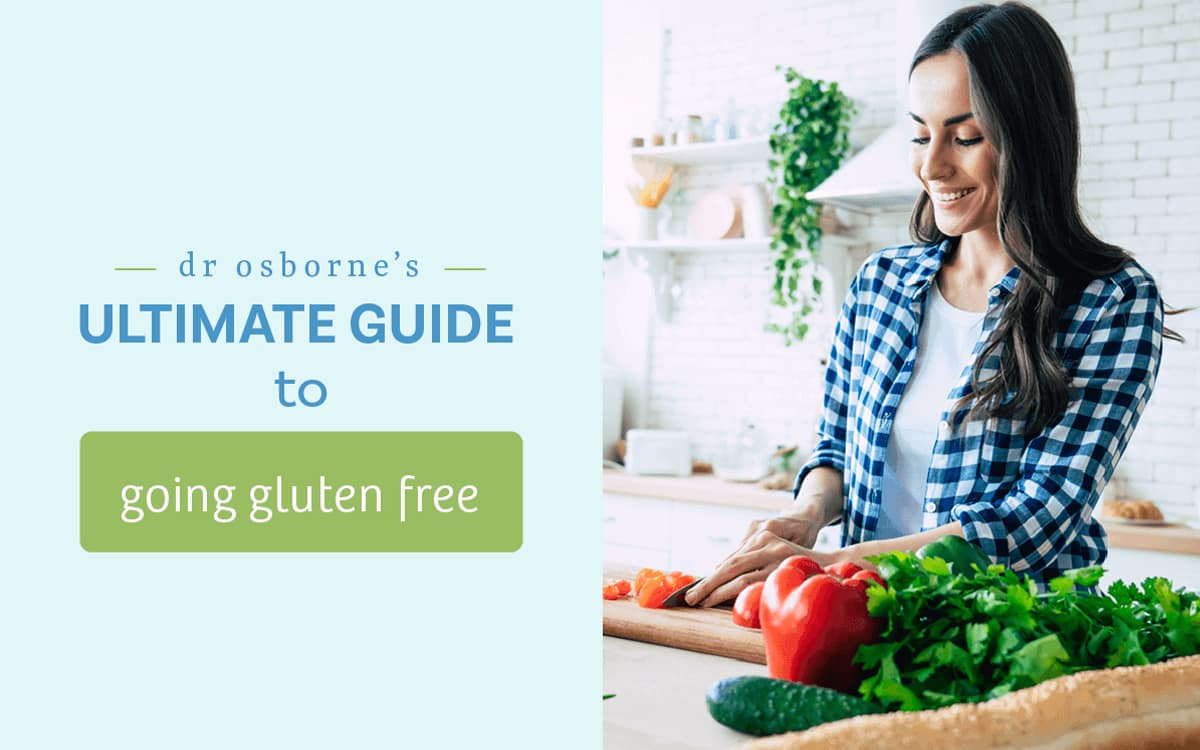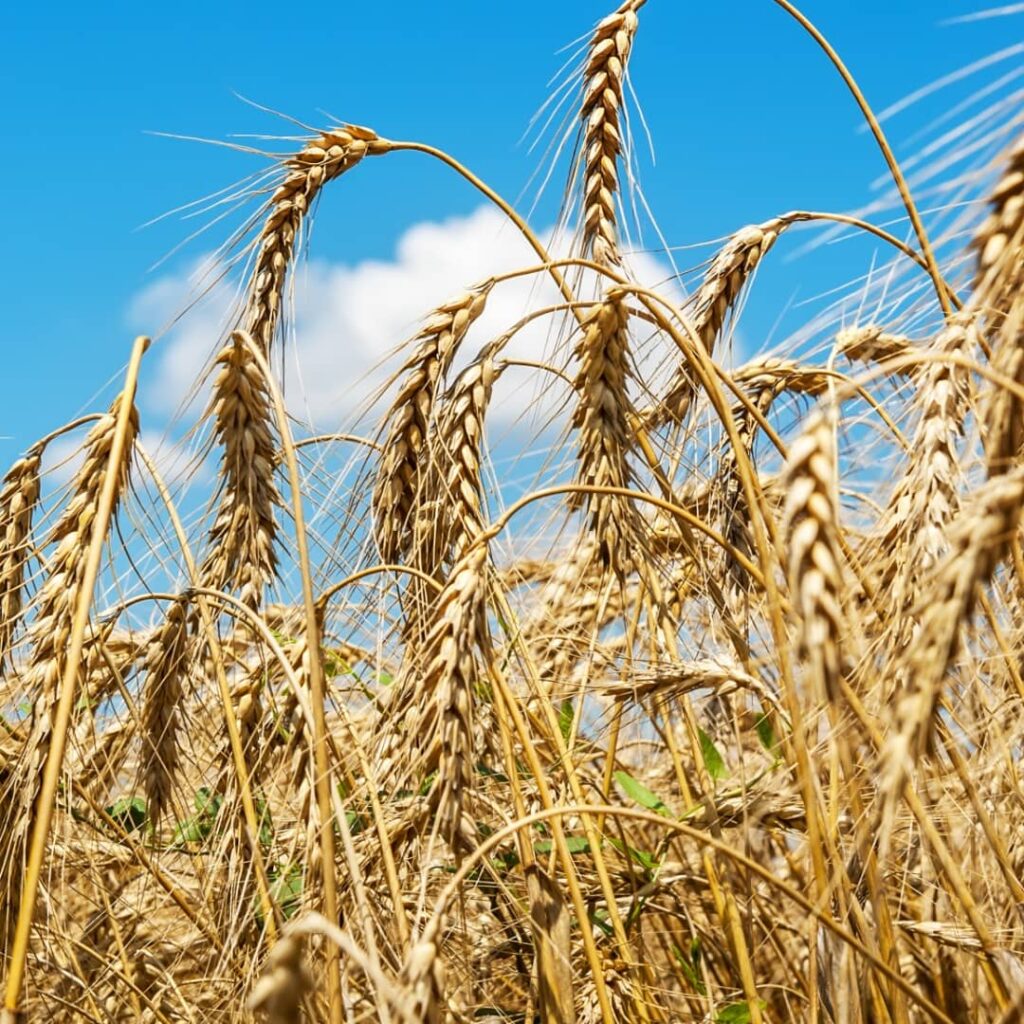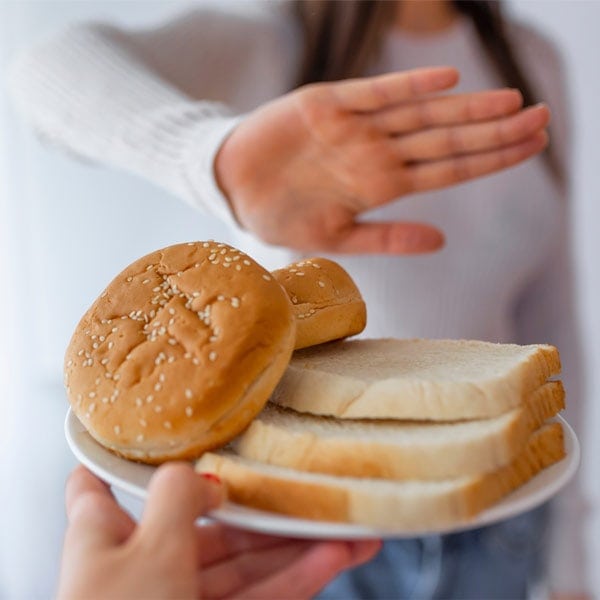new to the gluten free journey?
new to the gluten free journey?

People are removing gluten from their diet left and right— often to find that they’ve never felt better. But how do you know if a gluten-free diet is right for you? Not to mention, if you do decide to kiss gluten goodbye, what’s the best way to go about food?
Parting ways with gluten can be a challenging change for most people, but when it comes to achieving wellness and taking care of our health, one pesky ingredient shouldn’t get in the way. Whether you’ve noticed a gluten intolerance or other symptoms of celiac disease, you’re in the right place. Here’s our ultimate guide on how to go gluten-free, plus everything else you need to know to make the best decision for your body.
Contents
Toggle(Watch my video, What Is Gluten?)
 Gluten is defined as the family of alcohol-soluble proteins found in cereal grains. Grains are the seeds of grass. Different types of glutens are found in different grains, like rye, wheat, barley, and oats—by going gluten-free, you’re committing to giving up these grains. They can even be found in non-food sources, like when gluten is used as a base for certain medications. You can learn more in depth information by checking out our comprehensive crash course on gluten.
Gluten is defined as the family of alcohol-soluble proteins found in cereal grains. Grains are the seeds of grass. Different types of glutens are found in different grains, like rye, wheat, barley, and oats—by going gluten-free, you’re committing to giving up these grains. They can even be found in non-food sources, like when gluten is used as a base for certain medications. You can learn more in depth information by checking out our comprehensive crash course on gluten.
Aside from naturally-occurring gluten that we find in grains, there are also a lot of processed foods that use gluten. Gluten has glue-like properties that make flours found in bread more elastic, which adds to the shape and texture of bread and other foods. For this reason, gluten is often used as a base in a lot of foods to help with texture and consistency.
If you want to learn more about the protein gluten, check out this article: 49 Facts About Gluten You Might Not Know…
Unfortunately, some people are sensitive or intolerant to gluten. Having this sensitivity can cause a variety of negative reactions and symptoms, ranging from inconvenient discomfort to damaging diseases.
Celiac disease is the most well understood gluten induced disease. When someone with celiac disease eats gluten, their immune system launches an attack on the small intestine—specifically the villi, which are responsible for absorbing nutrients. This can be a source of great pain for many people, and it can cause a lot of other health issues. Note, though, that while everyone with celiac disease is gluten sensitive, not everyone with a gluten sensitivity or intolerance has celiac disease.
Having a gluten intolerance means that your body has a difficult time digesting or breaking down gluten. Being unable to properly process gluten can cause discomfort and contribute to a myriad of intestinal health symptoms such as gas, bloating, indigestion, and IBS.
Different from gluten intolerance, gluten sensitivity refers to the genetic predisposition that leads to an inflammatory immune response when a person eats gluten. This inflammation can contribute to damage anywhere in the body. Gluten sensitivity has been linked to a host of different diseases. Some of these include:
Read more about gluten sensitivity in our article here: What is Gluten Sensitivity? An Easy Explanation To Avoid All the Confusion…
 A strict gluten-free diet is the best, long-lasting primary treatment for gluten intolerance or celiac disease. In fact, it’s one of the only effective options for celiac disease since it is the only scientifically recognized cure. For those with celiac disease, a gluten-free diet is essential to not only feel better, but to avoid other dangerous or damaging health concerns.
A strict gluten-free diet is the best, long-lasting primary treatment for gluten intolerance or celiac disease. In fact, it’s one of the only effective options for celiac disease since it is the only scientifically recognized cure. For those with celiac disease, a gluten-free diet is essential to not only feel better, but to avoid other dangerous or damaging health concerns.
However, a gluten-free diet isn’t for everyone—it’s important to get tested for celiac disease or gluten sensitivity/ intolerance before you throw out all of the gluten in your house. For some, going gluten free when it is not necessary can put an undue burden on people socially and psychologically. Beyond these issues, eating a whole foods gluten-free diet when you aren’t gluten sensitive is not harmful, dangerous, or a cause of nutritional problems.
If you struggle with these symptoms or diseases, you should consider the possibility that gluten may be the cause.
If you have any family history of gluten intolerance or celiac disease, you should also get tested for gluten sensitivity.
Take our Sensitivity Test and get quick and reliable results that can help you in your decision to go gluten-free.
Gluten-free diets for beginners can be intimidating and overwhelming, so here are 5 quick tips on how to get started (and check out our all-things-gluten blog to learn more.)
A healthy gluten free diet is diverse in foods and nutrients. However; many who go gluten free rely heavily on packaged and processed gluten free foods that are devoid of adequate vitamins, minerals, fiber, and other nutrients. Consequently, nutritional deficiencies are a common risk associated with gluten-free diets, especially for beginners who aren’t sure how to balance everything out.
To avoid doing more harm than good, shop our wide variety of supplements, probiotics, and health products that can help you meet your nutritional goals without relying on gluten-filled foods. The more fresh your food is, the likelier it’s gluten-free. Some foods, like grains, simply aren’t an option; but plenty of clean-sourced meats, fruits, and veggies offer a lot of nutrients. Replace some of the nutrients you are losing by making sure you maintain a well-rounded diet with a variety of foods—our GFS recipes are a good place to start.
To successfully eat gluten-free, it is extremely important to read all the food labels of the products you purchase—gluten is added to more foods than you might initially think. Here are the common foods that you can include in your diet, plus certain foods to avoid with gluten intolerance.
Fruits and vegetables are naturally gluten-free and are loaded with essential vitamins. Including both in your diet will not only help you go gluten-free, but fruits and veggies are also key in balancing out the nutritional value you may lose by going gluten-free. Fruits and vegetables are also great snacks, so as you get used to having less access to food, you can turn to a variety of colorful, flavorful, and natural foods. Remember, though, that battered vegetables and candy-coated fruit likely still have some gluten.
Going gluten-free can also cause a fiber deficiency. Luckily, most nuts contain a lot of fiber and are naturally gluten-free, which means seeds and nuts are going to be a go-to source of protein and healthy fats. Nuts like pecans, walnuts, pine nuts, and almonds are all great options, especially for a quick healthy snack.
Gluten-free flour can be a game-changer for a lot of people, considering how much bread we eat during mealtime and the many recipes that call for flour. Use flours that are derived from coconut, almond, cassava, tapioca, or tigernut. When using flours, make sure to do your research on the brand you choose and read the labels—your safest bet is to go with brands that are gluten-free certified to avoid cross-contamination.
All grains contain gluten, but the definition of gluten for food labeling allows corn, rice, oats, and millet to be labeled gluten free. Eating these grains is not recommended, as many studies show that they can cause persistent inflammation. Additionally, it is recommended that you avoid the pseudo grains like amaranth, quinoa, and buckwheat, as these foods have been shown to be cross contaminated with gluten and lead to inflammation.
If you are trying to make foods that resemble the grain-containing staples you used to eat (i.e. bread, pizza, etc), consider arrowroot, cassava, and tapioca, as they have similar properties and texture. You might also consider Warrior Bread Mix as a substitute—be sure to check out our Warrior Bread Mix recipe library that includes recipes to make gluten-free hamburgers, pizza, muffins, pies, cookies, and so much more.
If you are buying gluten-free processed or pre-packaged foods make sure to read all food labels in depth before consumption, as many processed gluten-free substitutes are cross-contaminated.
Unflavored butter, milk, cheese, and other plain dairy products are technically gluten-free. That being said, dairy should be avoided if you have a gluten sensitivity because it has proteins in it that have been known to mimic gluten and cause similar inflammatory reactions.
All fish, poultry, and meats (and eggs) are conveniently and naturally gluten-free. However, meats prepared in restaurants are often battered with gluten-containing grains, so make sure you always inquire when eating out. Like with all the other food categories, beware of processed meats that may contain grain-based fillers, like hot dogs and lunch meat. Reading labels is a must.
While going gluten-free can be intimidating, it is essential if you are struggling with gluten sensitivity/intolerance or celiac disease. Many people benefit from going gluten-free, like experiencing healthy weight loss, boosted energy levels, less joint pain, and more. If gluten is getting in the way of your day-to-day functioning, then it’s worth making the adjustments to your food to have a happy, painless, and healthy life.
That said, the gluten-free diet is a huge commitment, so before you go all in, determine if you have an issue with gluten. If you suspect that you might be gluten sensitive, take our sensitivity test to get quick and reliable advice and results.
Stay up-to-date with the latest articles, tips, recipes and more.

*These statements have not been evaluated by the Food and Drug Administration. This product is not intended to diagnose, treat, cure or prevent any disease.
If you are pregnant, nursing, taking medication, or have a medical condition, consult your physician before using this product.
The entire contents of this website are based upon the opinions of Peter Osborne, unless otherwise noted. Individual articles are based upon the opinions of the respective author, who retains copyright as marked. The information on this website is not intended to replace a one-on-one relationship with a qualified health care professional and is not intended as medical advice. It is intended as a sharing of knowledge and information from the research and experience of Peter Osborne and his community. Peter Osborne encourages you to make your own health care decisions based upon your research and in partnership with a qualified health care professional.
10 Responses
Can I get a link to the videos for the 2023 No Grain No Pain challenge.
Here you go!
Part 1
Part 2
Part 3
Part 4
I heard Dr.Osborne say there was a 5 day free podcast or something to get in-depth info on gluten…..where do I find that? Thanks
Here you go – https://glutenology.net/registration
Hi! I get Bob’s Red Mill Organic Gluten Free Rolled Oats – are you saying that Oats have gluten?
Maggie, the following article and video might be helpful for you to better understand oats – https://www.glutenfreesociety.org/no-grain-no-pain-hidden-danger-oats/
Thanks so much for all the valuable info. I was on thyroid meds for hypothyroidism for 28 years. After 2years of gluten, dairy and sugar free diet my thyroid started funtioning by itself. After another year Im totaly off medication. Just wanted to share my testimony.
What does it mean if celiac tests are negative but gluten is positive?
Is organic tahini (ground sesame seeds, roasted or raw) an acceptable food? In your book No Pain No Grain, sesame oil is listed as acceptable when going on the Days 1 to 15 diet eliminating all grains. For phase two, Days 16 to 30 I don’t find any listing about sesame oil or seeds at all. Please reply. Tahini is a favorite food but will give it up for sake of my health if is needed!
Organic tahini is acceptable.
All the best,
Dr. O